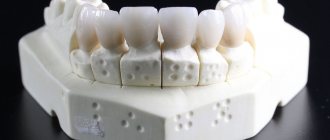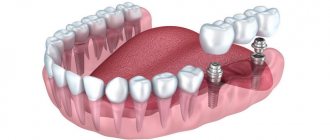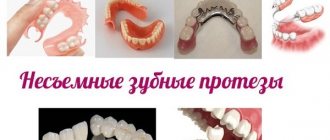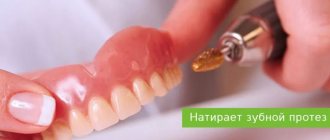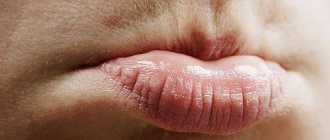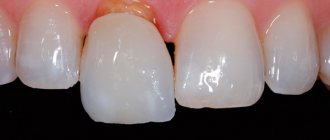An implant is a multicomponent system consisting of an intraosseous element and an abutment, an adapter between an artificial root and a prosthesis. The implant/abutment connection is precisely calibrated, without micro-gaps, with well-designed abutment positioning. These are important factors on which the correct distribution of the chewing load on the implant and the durability of the orthopedic system depend.
When a crown on an implant is loose, there is always a reason for it. If the implant itself remains motionless, most likely the fixing screw has been loosened or the crown has become uncemented (if it is cemented).
What to do? Go to an appointment with an orthopedist, who will determine the cause of the looseness and effectively solve the problem - replace the fixing component or reinstall the crown. The main thing is to accurately install a loose implant or crown. Indeed, in the first situation, reimplantation may be required, and the second option involves a simple adjustment of the coronal part; the implant itself does not need to be changed.
Reasons for crown mobility
In most cases, the mobility of the prosthesis has nothing to do with the qualifications of the implantologist. Among the main reasons are:
- Loosening of the screw connection between the abutment and the prosthesis
. This is possible if products from different brands were used. For example, the implant is Nobel Biocare, and the superstructure is Osstem. It is important to use original products of the same brand, which are developed as a whole, otherwise the likelihood of failure of all components is too high. - Loss of properties of the cement composition
. As a rule, this occurs due to high chewing load on the tooth, adherence to too hot or cold foods. The prosthetic system is fixed to the abutment with a soft cement composition; under unfavorable conditions, it begins to collapse, is gradually washed out, and the crown becomes loose.
The crown can be reattached in the clinic where the implantation was performed. The orthopedist will tighten the screw with an implantation key and secure the prosthesis. With the cement method of fastening, the crown will be cleaned of the remnants of the old composition and “set” on the cement again. Things are different if not only the crown, but the implant along with it is loose. It is very difficult to independently determine whether the implant crown is loose or the fixation of the intraosseous element is weakened. This requires a medical assessment of the clinical picture and a diagnostic examination.
General overview
Dental implants, integrated into the structure of bone tissue or the oral mucosa, can serve as the basis for various types of prosthetic systems:
- Permanent bridge-type structures;
- Single fixed or conditionally removable systems;
- Removable structures of full or partial replacement.
The implant itself is a product made of a biologically compatible material - usually titanium, in its pure form, or with the addition of alloys - consisting of two parts:
- The intraosseous part, or body of the implant, shaped like a cone, cylinder, or something in between. In rare cases, the rod can also be made in the form of a plate. The main functional task is to replace the root section of a lost tooth, taking over and then distributing the chewing load. The body of the implant is implanted into the structure of the bone tissue, and in case of its insufficiency and restrictions on plastic surgery, into the zygomatic or basal bone.
- An abutment is a fixing element that acts as a connecting link between the pin and the artificial crown that replaces the outer part of the tooth. The abutment transfers the load to which the prosthesis is exposed to the intraosseous body, and also provides protection against damage to the internal tissues of the jaw by pathogenic infections. In some cases, a monolithic design is allowed, when the implant and abutment are a single whole.
Attaching an artificial crown or prosthesis to an abutment involves the use of dental cement, as well as screw or ball-shaped retainers.
Implant mobility due to patient negligence
The main reason why the intraosseous structural element began to wobble is ignoring the recommendations regarding the care of implants and the orthopedic system fixed to them. If the surgeon performed the implantation without violating the protocol, 90% of the responsibility for rehabilitation lies with the patient. The following can lead to loosening of the structure:
- Refusal of medications prescribed by the surgeon for the speedy restoration of injured tissue, prevention of the inflammatory process, etc.
- Regular consumption of alcohol and smoking slow down the rate of engraftment of the artificial root, increases the risk of peri-implantitis, and impairs blood circulation in the tissues. Clinical studies have shown that implant failure in patients with bad habits is 3 times higher than in those who do not have them.
- Overload of the artificial root when chewing hard foods. Premature chewing load on the implant. Typically, the doctor recommends following a soft diet for 2-3 weeks after the intervention. Ignoring the recommendation leads to displacement of the implant in its bed, disruption of osseointegration and, as a consequence, rejection of the intraosseous element.
The survival rate of a titanium structure is also affected by systemic diseases accompanied by impaired regenerative processes. These include diabetes mellitus, immunodeficiency states, oncological processes, some pathologies of the central nervous system, and chronic processes in the oral cavity.
Preventive measures
To reduce the risk of the crown loosening and falling out, it is important to strictly follow the specialist’s instructions after the procedure, as well as maintain cleanliness and hygiene of the oral cavity. Here's what prosthetics experts recommend in this regard:
- brush your teeth twice a day, rinse your mouth after every meal, use floss. It is advisable to purchase an irrigator - a device that supplies a powerful air-water jet for better cleaning of hard-to-reach places. You can read more about the principle of operation of the irrigator and popular models of the device in our special article,
- follow some nutritional principles. For example, immediately after the procedure you will have to give up products that are too hard and stretchy. Subsequently, it is better to forget about the habit of gnawing seeds with your teeth and cracking the shell,
- It is better to quit smoking and drinking alcohol too often,
- treat the installed structure carefully and carefully, regularly check it for chips, cracks and other damage,
- When the first alarming symptoms appear, you should immediately consult a doctor.
To maintain your smile, proper dental hygiene is important.
After dentures, do not forget to visit the dentist every six months for preventive examinations and a professional. hygiene. At each such appointment, the doctor will evaluate not only the condition of the teeth and gums, but also the integrity and functionality of the installed dentures. If necessary, when the product’s expiration date approaches, a specialist will prescribe its timely replacement.
1Massironi, D. Precision and aesthetics. Clinical and dental stages of dental prosthetics, 2008.
What treatment methods are used
Treatment for mobility of the structure depends on the cause of the problem. If the implant crown is loose and the intraosseous element itself is motionless, it is again secured with a screw or cement. When the entire structure is wobbly, including the artificial root, treatment tactics are selected according to the clinical picture. The most favorable option is that the implant wobbles slightly, there is no inflammation around it, and the gums do not hurt.
In the second scenario, loosening of the artificial root occurs against the background of inflammation and pain in the jaw. Treatment includes:
- Cleaning the implant and nearby tissues - opening abscesses (if any), ultrasonic cleaning of plaque in the subgingival area.
- Osteoplasty using osteoplastic material and barrier membranes (according to indications).
- Antibacterial, antihistamine, anti-inflammatory agents.
- Treatment of the oral cavity with antiseptic compounds.
- X-ray control at each stage of treatment.
After the inflammation is eliminated, the prosthesis is again fixed to the implant. If the intraosseous element is rejected, it is removed from the socket, necrotic tissue is removed, and bone grafting is performed. Re-implantation is possible only after 6-8 months, when the bone mass has taken root and the tissue has recovered to its parameters.
First actions
Immediately after the crown has fallen off, decisions must be thoughtful and balanced. The supporting part is very sensitive to external influences, light touches, and temperature changes. When a crown falls off, you need to make an appointment with a doctor as soon as possible, preferably on the same day. At this time, it is better not to eat to avoid microbes getting into the base of the stump. If this is not possible, you should try to put the prosthesis back for a while. Of course, if a crown falls off, it is forbidden to use ordinary office or household glue - special compounds sold in pharmacies should be used. It is very important to maintain sterile cleanliness when the crown comes off - at this time any touch can lead to infection. First aid involves sequentially performing the following actions.
- Buy special dental cement at the pharmacy. A pharmacist can advise you which one to choose.
- Wash the denture under warm water and soap, then dry thoroughly. Avoid applying pressure as this may cause deformation.
- Clean the inlay area with a soft brush and paste without abrasive ingredients. Rinse your mouth with water.
- Apply cement evenly to the inner surface of the denture. You can use a wooden stick or toothpick for this.
- Carefully place the denture on the tab, being careful not to get the composition on the gum. It is better to perform the procedure in front of a mirror.
- After making sure that the product is level, release your hand and clench your teeth. Stay in this position for 2-3 minutes: this is enough to fix it.
- If excess cement has formed around, it must be removed with dental floss. It must be applied carefully, without strong tension.
ATTENTION! You should not experiment by testing untested methods of traditional medicine. Doctors also do not recommend using herbal infusions for rinsing. Tea made from chamomile, St. John's wort, and yarrow certainly has antiseptic properties, but may contain small particles of the herb, which, if they get under the prosthesis, often cause inflammation.
Rejection symptoms
Rejection of the intraosseous element is a serious complication leading to the loss of the metal pin. Usually, implant rejection is accompanied by quite eloquent symptoms:
- Swelling of the gums, which does not decrease within 5 days after the intervention, but, on the contrary, increases.
- Reddened mucous membrane around the artificial root.
- Severe pain that intensifies with any load on the structure.
- Bleeding of the gums around the implant for more than 4-5 days after implantation.
- Purulent discharge from a wound.
- The appearance of a putrid odor from the implantation area.
- Excessive mobility of the artificial root, exposure of its neck, subsidence of the gums.
- Deterioration in general health, increase in temperature.
A loose implant crown is a reason to urgently go to the dentist. Rejection is rarely treated. With such symptoms, the best option is to remove the implant from the bone with further drug therapy aimed at restoring the body and regenerating bone tissue.
Systemic diseases and body conditions affecting the fixation of implants
These include chronic diseases that make up the list of contraindications for implantation. They may go unnoticed or deliberately hidden by the patient, or appear much later, when the implant has been standing for several years.
Read about indications and contraindications for implantation in the feature article on the website “When you can or cannot place dental implants - a complete list of tolerances and prohibitions.”
Dental implant failure can occur due to the following diseases:
- diabetes mellitus in a long stage of decompensation,
- pathologies of the central nervous system,
- disruptions in the body's immune system,
- development of oncological tumors of any localization and subsequent therapy,
- allergic reactions in the oral cavity to the components of an implant or prosthesis,
- trauma of the maxillofacial apparatus,
- oral diseases
To avoid unexpected consequences of these diseases, experts recommend regular preventive oral examinations and monitoring of chronic diseases.
The implant fell out, what should I do?
In rare cases, the implant becomes unscrewed from the bone and may fall out. This occurs when the size of the socket and the intraosseous element do not match, as well as due to the weakness of the jaw bone. Such situations, when the implant loses its fixation and falls out, but there is no inflammation or other signs of rejection, can occur against the background of systemic diseases in which tissue regeneration is impaired (osteoporosis, diabetes mellitus). The problem is solved by reinstalling the structure using regenerative membranes (enriched with growth factors) that accelerate osseointegration, and prescribing a course of vitamin therapy.
Negative factors
The weakened position of the prosthetic structure placed on implants may be caused by one of the following factors:
- Displacement of the crown relative to the abutment;
- Displacement of the abutment in relation to the implant;
- Displacement of the implant in the bone structure.
Identifying the specific area where the problem arose is the first step towards solving it. In the case of the first and second factors mentioned, the main cause, as a rule, is a failure of fixation caused by the destruction of the cement base, rotation of the screw elements or loosening of the thread.
A much more serious problem is the third factor, which indicates rejection of the rod by the bone structure. Considering the complexity and duration of recovery of the body during implantation, an unsuccessful outcome of the operation causes a lot of inconvenience - both for the patient and the dentist. A similar situation may arise under the following circumstances:
- Failure to comply with the implant installation protocol;
- Failure to follow medical recommendations during the engraftment period;
- The presence of hidden systemic pathologies that have become a catalyst for rejection.
Regardless of the cause, at the first symptoms of an anomaly, it is recommended to immediately undergo additional examination using an X-ray machine or CT scan.
Prevention
The best treatment is prevention. The positive outcome of the operation is influenced by:
- Professional approach
– you need to take the choice of a clinic and an implantologist seriously, since the success of treatment depends 90% on the professionalism of the doctor. - Quality of diagnosis and preparation
- you need to prepare seriously for the operation, eliminating all contraindications. To do this, you need to undergo tests and not hide health problems from the surgeon - the more the doctor knows about the patient’s health condition, the more accurately he will select the implantation protocol, and the better the implantation of the artificial root will be. - Oral hygiene
– at the preparation stage, all dental problems should be eliminated and the quality of hygiene procedures performed should be improved.
After implantation, be sure to follow medical recommendations regarding care, nutrition, and physical activity. Do not skip control and preventative examinations.
We will definitely help!
The circumstance when the crown came off was not a pleasant one. The patient experiences many problems - from difficulties chewing food to psychological discomfort. The absence of an element in the mouth affects the smile and diction: often a person begins to lisp or involuntarily whistle, which is why he tries to reduce communication with others to a minimum. Complexes arise, problems appear in the family and at work. Nowadays, it is difficult to achieve serious success without a well-groomed appearance and good health, the indicator of which is a beautiful smile. This means that the circumstances under which the crown may fall off must be excluded. This will be done by the experienced dentists of our clinic, who have had to deal with similar cases more than once. The main thing is to identify the correct cause, which X-rays will help with. When the crown comes off, the doctor will put the prosthesis in place if everything is fine with it, or make a new one if it is deformed. If the cause is in the tab, treatment will be required. In any case, our employees will make every effort to quickly and painlessly restore the integrity of the dentition.
- We use modern technologies and the latest generation drugs.
- We employ dentists with higher education and extensive experience.
- We comply with strict hygiene requirements and sanitary standards.
- Each department has its own laboratory facilities.
- The cost is quite affordable, many services can be obtained free of charge under compulsory medical insurance.
- There is a flexible system of discounts, and it is possible to pay for treatment in installments.
- The branches are located in close proximity to metro stations.
- We work seven days a week and on holidays, and visitors are always welcome.
An official contract is concluded with each patient and a guarantee is provided. We try to approach each case individually, understanding how unpleasant the episode when the crown comes off is. Restoring aesthetics and functionality is the responsibility of dentists, which our doctors treat with reverence and care. It is important to establish informal contact with the client - without mutual trust it is difficult to achieve success in any business. During the period when a crown has fallen off, the moral support that the staff of the VivaDent clinic tries to provide to each visitor is especially important. That is why there are so many grateful reviews from patients whom we have helped. If a crown has fallen off, we invite you to any of our branches. Consultants will help you choose the nearest one and sign up for a convenient time by phone or using the online form on the website. Our doors are always open to visitors!
